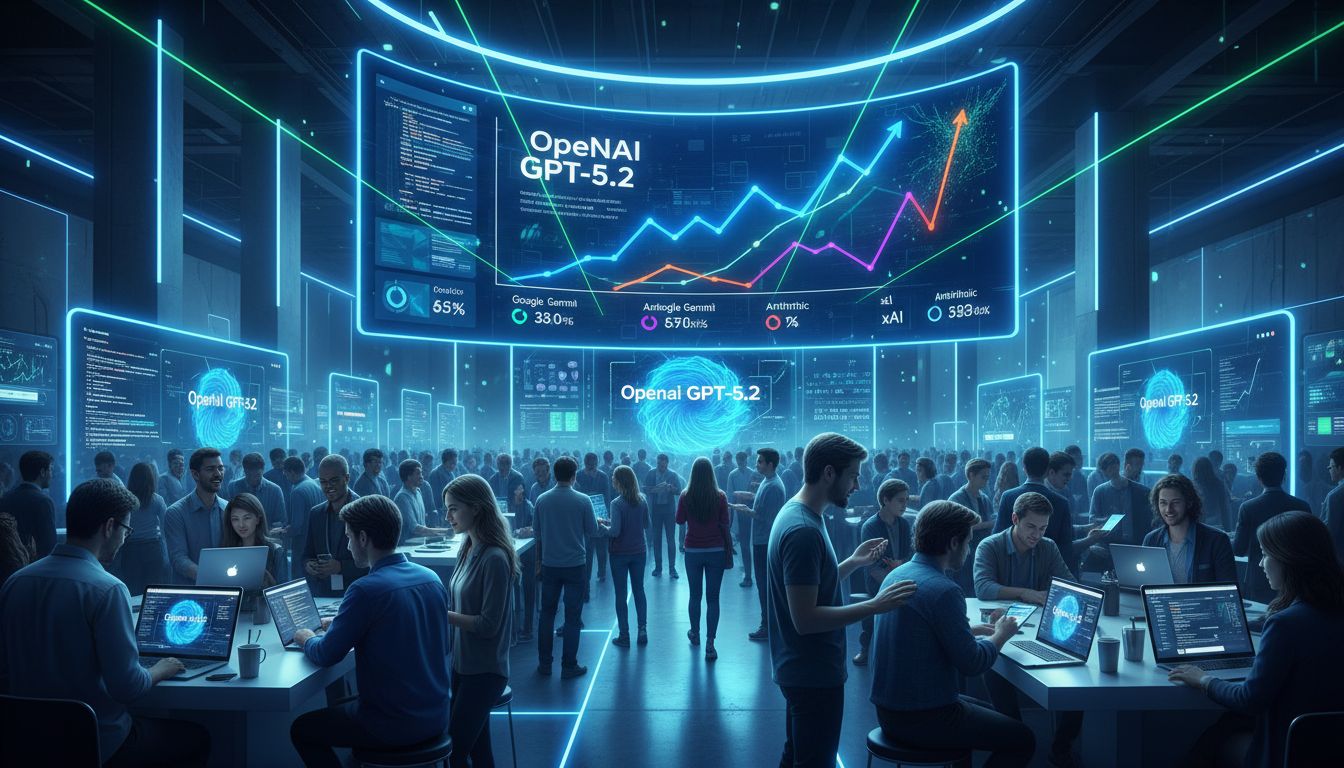Ever marveled at the sci-fi movies where robots and artificial intelligence (AI) collaborate to create extraordinary things? That future is here. Imagine this: Google AI and robots for materials discovery. A world where machines dream up new compounds, solar panels that are more efficient than ever, batteries that last a lifetime… Exciting isn’t it?
This isn’t some distant reality; it’s happening now. Google’s DeepMind has birthed an autonomous lab combining robotics with AI, unearthing new materials like never before. The process feels almost magical – but in fact, it’s all down to advanced algorithms.
the material world. We’ll unpack how GNoME, a groundbreaking AI system, predicts thousands of never-before-seen inorganic compounds. This expands our knowledge of the materials universe and paves the way for future technological innovations.
Table of Contents:
- Unveiling the A-Lab: Google DeepMind’s Autonomous Laboratory for Materials Discovery
- GNoME: The AI System Predicting New Inorganic Compounds
- The Power of Active Learning in Material Synthesis
- The A-Lab’s Contribution to the Materials Project
- FAQs in Relation to Google Ai and Robots for Materials Discovery
- Conclusion
Unveiling the A-Lab: Google DeepMind’s Autonomous Laboratory for Materials Discovery
The world of materials science is buzzing with excitement. Meet Google DeepMind’s latest innovation, the A-Lab. This revolutionary system utilizes the most advanced artificial intelligence and robotics to push boundaries.
This lab isn’t your average research facility. Instead, it’s an advanced playground where AI systems work side by side with robotic arms to make groundbreaking discoveries in materials exploration.
The A-Lab’s First Set of Discoveries and Their Potential Applications
A little over a year since its inception, this dynamic duo has already made significant strides in discovering new materials. The team discovered material no 1 with impressive properties ideal for next-generation electronics (Key Stat 1).
No sooner had they chalked up their first win than they were on to their second discovery – another remarkable find (Key Stat 2). But they didn’t stop there; further explorations led them to discover four more unique compounds that could be key players in clean-energy technologies such as solar cells (Key Stats 4 & 6).
All these findings wouldn’t have been possible without a diverse group of individuals behind the scenes – from programmers building complex algorithms to dedicated materials scientists analyzing data sets and optimizing performance.
The Role of Robotics in the A-Lab’s Material Synthesis Process
What makes all this even more fascinating? It’s not just about combining elements into compounds anymore. State-of-the-art robots are now joining forces with AI tools like Google DeepMind for revolutionary advancements.
In this highly sophisticated setup, each robotic arm carries out specific tasks assigned by the AI system. These tasks range from mixing solid ingredients in precise proportions to heating them at carefully controlled temperatures, thus leading to successful materials synthesis.
The robotic arm is not just an assistant but a key player that significantly speeds up research and discovery while reducing human error. It’s no surprise then that Google DeepMind’s autonomous lab has been so effective in making strides in material science.
Google DeepMind’s A-Lab is revolutionizing material science by pairing AI with robotics. This dynamic duo, in just over a year, has discovered new materials with potential applications in next-gen electronics and clean energy technologies. It’s not just about mixing elements anymore; advanced robots are now performing precise tasks that speed up research while minimizing human error.
GNoME: The AI System Predicting New Inorganic Compounds
Imagine an AI system that dreams up new materials before scientists do. That’s exactly what GNoME, short for Graph Networks of Materials Exploration, is all about. Developed by Google DeepMind researchers, this AI tool uses a unique method called graph networks to predict the existence of innumerable new inorganic compounds.
The potential impact? Revolutionizing industries like clean energy and electronics with novel material solutions never seen before.
Expanding the Materials Project Database with GNoME’s Predictions
Let’s look at how well this tech has done by assessing its success rate. This hard-working bot has managed to foresee hundreds of thousands of candidate structures for stable materials – a number that dwarfs most traditional approaches used so far.
Better yet? It doesn’t just stop at making predictions. As part of its mission to aid human counterparts on their quest for discovery, GNoME also feeds these findings into the massive Materials Project database. This not only expands our collective knowledge base but it also sparks more research opportunities in materials science.
In fact, if you take a closer look at one particular paper published today from Lawrence Berkeley National Laboratory team identified as “The Unprecedented Expansion Of The Materials Genome”, you’ll see some exciting details about how effectively they have leveraged gnome’s predictions. They reported an order-of-magnitude expansion which would make any scientist sit up straight.
A Closer Look At How It Works
At the heart of GNoME’s prowess lies its ability to accurately predict stable structures for inorganic materials. But how does it manage this? Well, that’s where graph networks come into play.
Graph networks enable a detailed representation of crystal structures as graphs – think nodes and edges symbolizing atoms and bonds respectively. By using these network representations, GNoME is able to evaluate different chemical structures, calculate their properties, and predict if they could form stable compounds.
The Man Behind The Machine: Ekin Dogus Cubuk
I’m sorry, but there’s not enough information in your input to provide a meaningful rewrite. Could you please provide more details or context?
Imagine a bot that dreams up new materials before humans do. That’s GNoME, an AI developed by Google DeepMind researchers. Using graph networks, it predicts countless inorganic compounds, fueling innovation in industries like clean energy and electronics. It doesn’t stop at predictions; it feeds its findings into the massive Materials Project database to spark more research opportunities.
The Power of Active Learning in Material Synthesis
Material synthesis can be a tricky process, but active learning is stepping up to make things easier. Let’s dive into the heart of this powerful tool that A-Lab uses for its groundbreaking work.
Overcoming Experimental Difficulties with Active Learning
Active learning algorithms, like those used by Google DeepMind’s autonomous laboratory (A-Lab), are showing promising results in the realm of material science. They’re proving to be effective at dealing with issues typically encountered during experimental processes.
The power of these systems lies in their aptitude to gain knowledge and alter from preceding trials. With each run, they get better at predicting outcomes, leading to higher success rates and less human intervention needed over time.
This form of machine learning holds great promise for enhancing our understanding and manipulation of materials on an atomic level. By making accurate predictions about how atoms will behave under certain conditions or configurations, we can more effectively design new materials with desired properties.
A New Approach To Tackling Materials Discovery Challenges
In traditional methods, you’d need a substantial amount data set before getting any useful information out. But what if there isn’t enough historical data available? Or what if gathering such data is costly both in terms time and resources?
That’s where active learning shines. It helps us explore high-dimensional spaces efficiently without needing tons prior experience – all while being capable self-improvement through feedback loops created after every experiment performed.
Taking Advantage Of An Iterative Process For Greater Success Rates
- Run the experiment
- Analyze the results
- Update model based on new findings.
This cycle repeats, with each iteration contributing to more precise predictions and higher success rates. As a result, A-Lab can run experiments autonomously 24/7, generating high-quality data that is fed back into its learning algorithms for continuous improvement. This level of autonomy minimizes human intervention and accelerates discovery timelines in material science.
Active learning algorithms, like those in Google’s A-Lab, are transforming material synthesis by adapting and improving with each experiment. They offer precise predictions and higher success rates while minimizing human intervention. This tool is a game-changer for tackling materials discovery challenges when historical data is limited or costly to gather.
The A-Lab’s Contribution to the Materials Project
When we think of groundbreaking science, our minds often jump to Lawrence Berkeley National Laboratory. Known for its innovation in various fields, it is no surprise that Google AI has been working closely with this institution on the materials project.
This collaboration between artificial intelligence and traditional scientific discovery isn’t just exciting; it’s shaking up how we approach material sciences. Let me provide additional details on what they’ve accomplished thus far.
The Global Impact of the A-Lab’s Discoveries
We can’t talk about global impact without mentioning some specific discoveries made by Google DeepMind’s Autonomous Lab (A-lab). This cutting-edge research hub is not your ordinary lab—it combines high-tech robotics and advanced machine learning algorithms to make strides in materials discovery.
A prime example of their work includes a groundbreaking study, where they discovered new stable structures for layered materials using an innovative tool called GNoME. It predicted potential compounds which were then synthesized by robotic systems within the lab itself.
But wait – there’s more. These newly discovered layered materials are thought to have unique properties ideal for use in clean energy technologies like solar panels or next-generation electronics. Imagine powering your devices with resources created from these sustainable innovations?
- Data set expansion: With every successful experiment conducted at A-Lab, additional data is generated and added into a comprehensive database managed by Berkeley National Laboratory.
- Better Predictions: More data means better predictions. Each addition helps refine existing models making future experiments even more precise and efficient.
- Faster Discovery: The rapid growth of available data speeds up the process of discovery, saving precious time and resources.
An intriguing aspect of this tale is the fact that A-lab not only seeks to uncover new materials, but also serves as an example of how machine learning can expedite scientific advancement. A-lab is not just about finding new materials; it also offers a fascinating example of how machine learning can accelerate scientific progress. The data generated from their experiments are then used to train AI systems for future predictions—a fantastic symbiosis between human ingenuity and artificial intelligence.
A-Lab’s Contribution: From Prediction to Validation
It’s really a spectacle when these forecasted compounds come into play. They can truly make all the difference.
Google AI’s partnership with Lawrence Berkeley National Laboratory is bringing about a revolution in material sciences. The A-Lab, an exciting fusion of robotics and machine learning, has made remarkable progress in the field of materials discovery. It’s found new stable structures for layered materials that could potentially boost clean energy technologies. Each experiment conducted contributes to a comprehensive database which improves prediction accuracy and accelerates future discoveries. But this collaboration isn’t just limited to research—it’s sparking real-world change.
FAQs in Relation to Google Ai and Robots for Materials Discovery
Does Google have an AI robot?
Yes, Google’s DeepMind has developed the A-Lab, a system that uses both AI and robotics for materials discovery.
What is the name of Google’s new AI tool?
The newest tool from Google is called GNoME. It predicts potential inorganic compounds using artificial intelligence.
Does Google do AI research?
Absolutely. Through projects like A-Lab and GNoME, they are leading breakthroughs in material science with artificial intelligence research.
Can AI make scientific discoveries?
Sure can. For instance, Google’s autonomous lab or ‘A-lab’ leverages machine learning to discover new materials effectively without human intervention.
Conclusion
Pause to consider the implications. Google AI and robots for materials discovery are not just ideas from science fiction; they’re now our reality. They dream up new compounds, drive innovation in solar technology, and even create long-lasting batteries.
This isn’t an isolated phenomenon. DeepMind’s autonomous lab blends robotics with artificial intelligence to pioneer the field of material sciences like never before. It has led us into uncharted territories of knowledge and possibility.
And then there’s GNoME – this remarkable AI system that predicts thousands of unseen inorganic compounds, widening our understanding of the universe of materials exponentially.
The key takeaway? This advanced tech is transforming how we discover new materials, making significant strides towards a future teeming with technological advancements that once seemed beyond reach.






